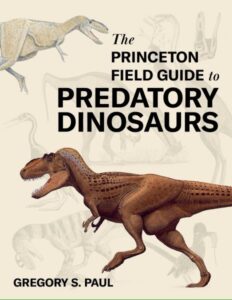 As with so many naturalists today, my first love in the world of natural history studies was dinosaurs. As a boy, I would expound upon these remarkable creatures ad nauseam to anyone willing or foolishly indulgent enough to listen. Of course, this was long before the first Jurassic Park film and the subsequent popular surge in interest in dinosaurs – at least as pop culture images. However along with the mountains of kitsch generated by that film franchise, a number of interesting and informative books have also been published about dinosaurs in recent years; books that my young self would have given most anything to have been able to read as they far surpass the worn and dog-eared old picture books to which I had access in my youth (some of which even included early humans depicted as existing concurrently with the great beasts).
As with so many naturalists today, my first love in the world of natural history studies was dinosaurs. As a boy, I would expound upon these remarkable creatures ad nauseam to anyone willing or foolishly indulgent enough to listen. Of course, this was long before the first Jurassic Park film and the subsequent popular surge in interest in dinosaurs – at least as pop culture images. However along with the mountains of kitsch generated by that film franchise, a number of interesting and informative books have also been published about dinosaurs in recent years; books that my young self would have given most anything to have been able to read as they far surpass the worn and dog-eared old picture books to which I had access in my youth (some of which even included early humans depicted as existing concurrently with the great beasts).
Yet of all the books of recent years that I now have seen published, few can surpass the wonder-filled, imagination-inspiring works of Gregory S. Paul published by Princeton University Press. Published under the Princeton Field Guide series and beginning with The Princeton Field Guide to Dinosaurs in 2010, the collection now numbers four volumes, including the third edition of the inaugural volume published earlier this year.
 Most recently, the fourth (or sixth, depending if you wish to count individual editions and not only titles) volume, The Princeton Field Guide to Predatory Dinosaurs, was published just this past November. Covering some 300-odd theropod dinosaurs, including such now iconic genera as the Tyrannosaurs and Velociraptors, this new addition to the collection follows the same over-size format as previous volumes in the series, presenting its subject in both black and white as well as vivid colour illustrations, all thoroughly supported with extensive explanatory text presenting the history and biology of these remarkable creatures, as well as much food for thought regarding their extinction and possible species that may have existed but for which insufficient fossil evidence has yet been found.
Most recently, the fourth (or sixth, depending if you wish to count individual editions and not only titles) volume, The Princeton Field Guide to Predatory Dinosaurs, was published just this past November. Covering some 300-odd theropod dinosaurs, including such now iconic genera as the Tyrannosaurs and Velociraptors, this new addition to the collection follows the same over-size format as previous volumes in the series, presenting its subject in both black and white as well as vivid colour illustrations, all thoroughly supported with extensive explanatory text presenting the history and biology of these remarkable creatures, as well as much food for thought regarding their extinction and possible species that may have existed but for which insufficient fossil evidence has yet been found.
As this is the holiday gift giving season, if you have a budding young – or greying old, for that matter – dinosaur enthusiast on your list, one of these volumes make an exceptionally nice gift, or if you’re feeling particularly generous, the entire set. Of course, if you yourself have been particularly good this year, treating yourself to one or more is also heartily encouraged.
For ease of reference the entire series as it presently stands is as follows:
- The Princeton Field Guide to Pterosaurs (2022)
- The Princeton Field Guide to Mesozoic Sea Reptiles (2022)
- The Princeton Field Guide to Dinosaurs (third edition, 2024)
- The Princeton Field Guide to Predatory Dinosaurs (2024)
If you enjoyed reading this, please consider signing up for The Well-read Naturalist's newsletter. You'll receive a helpful list of recently published reviews, short essays, and notes about books in your e-mail inbox once each fortnight.
